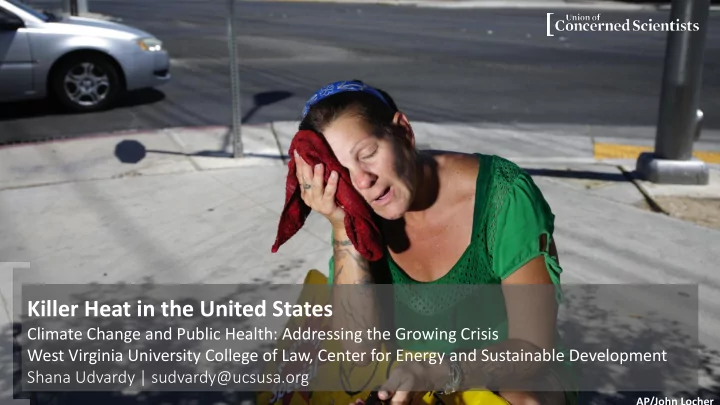

Killer Heat in the United States Climate Change and Public Health: Addressing the Growing Crisis West Virginia University College of Law, Center for Energy and Sustainable Development Shana Udvardy | sudvardy@ucsusa.org AP/John Locher
1 ℃ World 2.00 Global temperature change relative to 1.75 1.50 1850-1900 ( ° C) 1.25 1.00 Human-induced warming 0.75 0.50 0.25 0.00 1960 1980 2000 2020 2040 2060 2080 2100 IPCC 2018 SR15 Fig FAQ 1.2
Habitat loss due to global warming 18% 16% 8% +2 ° C +1.5 ° C 9.6% 8% 4% INSECTS PLANTS VERTEBRATES IPCC SR15 2018 SPM
ultramarinfoto / Getty Images
Chasing Coral NOAA
Current warming rate Global temperature change relative to 1850-1900 (°C) 2.00 1.75 1.50 1.25 1.00 Human-induced 0.75 warming 0.50 0.25 0.00 1960 1980 2000 2020 2040 2060 2080 2100 IPCC 2018 SR15 Fig FAQ 1.2
Current warming rate Global temperature change relative to 1850-1900 ( ° C) 2.00 1.75 1.50 1.25 1.00 Human-induced warming 0.75 0.50 0.25 0.00 1960 1980 2000 2020 2040 2060 2080 2100 IPCC 2018 SR15 Fig FAQ 1.2
About our analysis • Use temperature and humidity to calculate heat in index • High-resolution climate models • Three future emissions scenarios • Data for every community in the lower 48
Extreme heat on the rise Heat Wave Frequency 5 4.5 4 Average days per year 3.5 3 2.5 2 1.5 1 0.5 0 1960s 1970s 1980s 1990s 2000s Habeeb et al., 2015
Extreme heat on the rise Heat Wave Intensity 2.5 2 Average days per year 1.5 1 0.5 0 1960s 1970s 1980s 1990s 2000s Habeeb et al., 2015
Extreme heat on the rise Length of Heat Season 60 50 Average days per year 40 30 20 10 0 1960s 1970s 1980s 1990s 2000s Habeeb et al., 2015
NOAA 2019 Fall 3-month Outlook
NOAA 2020 Fall 3-month Outlook
“We have seen a huge spike in ER visits and admissions…in the past several weeks. Huge. We have been admitting people left and right.” --Dr. Arash Armin, Trenton, MI. Ju July 19, , 2019 AP/Richmond Times-Dispatch/P. Kevin Morley
About the Heat Index For Example: 90⁰F and a relative humidity of 60%, the heat index is 100 ⁰F.
“Off the Charts” Conditions
About the scenarios
Midcentury (2036-2065): Steep increase in extreme heat
Midcentury (2036-2065): Steep increase in extreme heat
Cities with frequent, dangerous heat
Cities with frequent, dangerous heat • 150 Cit itie ies • 92 Mil illion people
I >105 ° F for African Americans Mid idcentury: Days per year with HI
Unprecedented heat late century (2070-2099): 105⁰ F + 8x as many days per year
Unprecedented heat late century (2070-2099): Off the charts • Historically only affected the Sonoran Desert region for a couple days per year • > 60% of the US (by area) would experience these conditions at least 1x per year.
Unprecedented heat late century (2070-2099): Off the charts • Historically only affected the Sonoran Desert region for a couple days per year • > 60% of the US (by area) would experience these conditions at least 1x per year. • 120 million people would experience 7+ days of off- the-charts heat in an average year compared with <2,000 people today.
Good News?
Taking action now would limit expansion of heat
Takeaways • Failing to take action to reduce emissions would lead to a staggering expansion of dangerous heat. • Aggressively reducing emissions could contain that expansion. • The time to act is now.
Adaptation : Mitigation: Keeping People Safe Reaching net zero emissions by 2050 + Credit: AP Photo David Goldman
Keeping workers safe from extreme heat National Occupational Safety Standards for Heat • H.R.3668 - Asuncion Valdivia Heat Illness and Fatality AP: Rich Pedroncelli Prevention Act of 2019 AP Photo: Charlie Riedel
Transitioning away from fossil fuels Power sector [28%] and transportation [29%] industrial [22%], C&R buildings [12%], agriculture [9%]: Fed, state, local, individual
Renewable electricity standard • ↑ renewable electricity from 18% in 2018 to at least 50% in 2035 • Nearly eliminate coal & reduce natural gas by 38% • ↓ power sector CO2 emissions 46% in 2035 • = $34 billion in savings to consumers energy bills between 2020 and 2035
UCS Resources
http://www.ucsusa.org/killer-heat Interactive data widget
http://www.ucsusa.org/killer-heat Interactive maps
Congressional district map
Congressional district fact sheets (433): What you can do 1) Reach out on social media. 2) Follow your representatives’ or other public figures’ Facebook pages or Twitter accounts. 3) Attend a members’ forum or event. 4) Write a letter to the editor for your local paper.
We can do this! Thank You!
Recommend
More recommend